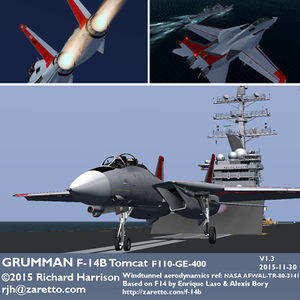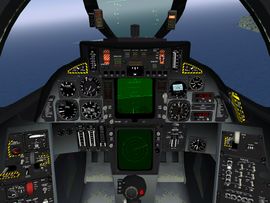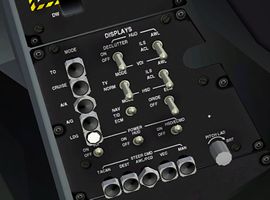Grumman F-14 Tomcat
 | |
| Type | Interceptor, multi-role Fighter aircraft |
|---|---|
| Author(s) | Enrique Laso, Alexis Bory (cockpit) |
| FDM | YASim |
| --aircraft= | f-14b |
| Status | Production |
The Grumman F-14 Tomcat is a supersonic, twin-engine, two-seat, variable geometry wing aircraft. The F-14 was the United States Navy's primary maritime air superiority fighter, fleet defense interceptor and tactical reconnaissance platform from 1974 to 2006. It later performed precision strike missions once it was integrated with the Low Altitude Navigation and Targeting Infrared for Night LANTIRN system. The F-14 was developed after the collapse of the F-111B project, and was the first of the American teen-series fighters which were designed incorporating the experience of air combat in Vietnam against MiGs.
It entered service in 1972 with the U.S. Navy, replacing the F-4 Phantom II. It was later exported to the former Imperial Iranian Air Force in 1976, during a time when the US still had good relations with Iran. It was retired from the active U.S. Navy fleet on 22 September 2006, having been replaced by the F/A-18E/F Super Hornet. As of 2007, it remains in service only with the Islamic Republic of Iran Air Force.
Keyboard Controls
Flight Controls
| Home | Increase elevator trim |
| End | Decrease elevator trim |
| ] or f | Lower flaps |
| [ or F | Raise flaps |
| s | Increase speed brakes |
| S | Decrease speed brakes |
Automatic Flight controls
| a | Toggle APC (Landing Automatic Power control) |
| Ctrl-d | Toggle DLC (Landing Direct Lift Control) |
| d | DLC increase |
| D | DLC decrease |
| Ctrl-t | Toggle AFCS (Defaut Attitude Mode) |
| Ctrl-a | Enable AFCS Altitude Mode |
| * | Engage AFCS Altitude Mode |
| Ctrl-h | Enable AFCS Heading Mode |
| Ctrl-s | Toggle ground spoilers armed |
HSD - radar and RWR
| h | Cycles through HSD modes: radar - compas - ECM (RWR) |
| E | Decrease Radar Range |
| R | Increase Radar Range |
| Ctrl-r | Toggles Radar Standby Mode. In standby mode the radar doesn't emit and the "STAND BY" words are displayed on the HSD screen when in TID mode. |
Miscellaneous
| e | Toggle canopy and access ladder |
| u | Toggle refuelling probe |
| Ctrl-o | Toggle oversweep (on ground only, otherwise sweep is automatic) |
Aircraft help
On Shore Takeoff
- With wings on over sweep position (parking position) the elevator command is inhibited... just in case...
- Check air brake in.
- Fuel level: The Flighfgear F-14 has a 10% fuel level and no external load at start up. This means the aircraft will be very light and have a strong tendency to raise the nose when accelerating on the runway. With less weight on the nose wheel, the nose wheel steering loose its efficiency. If the pilot use afterburners for take off, the loose of nose wheel steering efficiency is increased (afterburners are not necessary for take off). Set a suitable fuel level before take off.
- Flaps: Set full flaps.
- Elevators: The pilot will need to maintain a correct (leveled) attitude using the stick. Push the stick forward to prevent nose pitching up at the begining of the take off run, release slightly as speed increase, pull smoothly when reaching rotation speed (150kts).
- Rudder: Currently the FDM use a small rudder rate of move to damp some nasty oscillations when the rudder is not moved enough smoothly. If not anticipated, this delay will cause overshooting the desired rudder effect, then a strong counter action on the rudder will be applied by the pilot on the rudder with again an overshoot... That's a typical pilot-induced oscillation. To avoid this set a small amount of rudder, wait for the effect, see if it's enough, then add a small amount of rudder again if needed... when doing so the pilot will prefer increasing the power smoothly. Now the aircraft will quickly gain speed while covering the runway and the rudder effect will increase thus decreasing the needed delay and the amount of pressure on the stick to match the desired effect.
Pilot's Cockpit
Displays Control Panel
- The Display Control Panel is located on the right side of the pilot's main panel, under the Hook lever. The 3 botom switches respectively turn the VDI, HUD and HSD displays on/off. The HSD MODE switch is also available, it selects NAV or TID or ECM mode. This can also be achieved by cycling through these 3 modes with the "h" key. (Note: the NAV MODE push buttons - TO, CRUISE, A/A, A/G, LDG - are not operational yet.)
- VDI: Vertical Display Indicator. Shows the aircraft attitude in roll and pitch, with an artifitial horizon and magnetic heading.
- HUD: Head UP Display.
- HSD: Horizontal Situation Display. HSD shows either:
- in NAV mode: compas with navigation indications,
- in TID mode (Tactical Information Display): an horizontal representation of the tactical situation (that is informations provided by the RIO from what he sees in his radar displays).
- in ECM mode: a representation of radar threats around the Aircraft.
Related content
Related lists
| |||||

